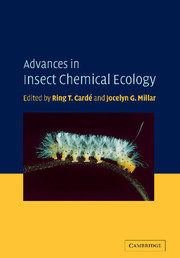Book contents
- Frontmatter
- Contents
- List of contributors
- Preface
- 1 Phytochemical diversity of insect defenses in tropical and temperate plant families
- 2 Recruitment of predators and parasitoids by herbivore-injured plants
- 3 Chemical ecology of astigmatid mites
- 4 Semiochemistry of spiders
- 5 Why do flowers smell? The chemical ecology of fragrance-driven pollination
- 6 Sex pheromones of cockroaches
- 7 A quest for alkaloids: the curious relationship between tiger moths and plants containing pyrrolizidine alkaloids
- 8 Structure of the pheromone communication channel in moths
- Index
- References
8 - Structure of the pheromone communication channel in moths
Published online by Cambridge University Press: 07 August 2009
- Frontmatter
- Contents
- List of contributors
- Preface
- 1 Phytochemical diversity of insect defenses in tropical and temperate plant families
- 2 Recruitment of predators and parasitoids by herbivore-injured plants
- 3 Chemical ecology of astigmatid mites
- 4 Semiochemistry of spiders
- 5 Why do flowers smell? The chemical ecology of fragrance-driven pollination
- 6 Sex pheromones of cockroaches
- 7 A quest for alkaloids: the curious relationship between tiger moths and plants containing pyrrolizidine alkaloids
- 8 Structure of the pheromone communication channel in moths
- Index
- References
Summary
Introduction
Moths are among the most speciose of insect groups, comprising perhaps 140 000 species, despite their remarkably undiversified and almost exclusively phytophagous larval lifestyle. Among the factors that are likely to have promoted such speciose success is their ability to persist at relatively low densities, facilitated by a pheromone communication system that allows males to locate conspecific females over distances of tens and in some species perhaps thousands of meters. The pheromone communication system also serves a primary basis of premating (prezygotic) reproductive isolation among species. Chemical communication channels that are distinctive at the species level permit the co-existence of many species in the same habitat or region. Although there is no firm evidence yet that the process of speciation itself has been fostered by splitting of the pheromone channel in sympatry, there are saltational mechanisms that could account for a rapid shift in the compounds produced by the emitter and a parallel tracking shift in the responder. There also are a few cases which suggest that either reinforcement or communication interference has caused divergence of chemical channels. Nonetheless, how changes in these communication systems evolve remains largely speculative. We also have no explanation for why in some species the female's production of a pheromone blend is variable and in others highly canalized.
Long-distance mate location that is mediated by pheromones is true “communication” as defined by Burghardt (1970), in that there are selective constraints on both the females' production of the signal and the males' response – in other words, selection favors some individuals over others in finding a mate.
- Type
- Chapter
- Information
- Advances in Insect Chemical Ecology , pp. 283 - 332Publisher: Cambridge University PressPrint publication year: 2004
References
- 103
- Cited by



